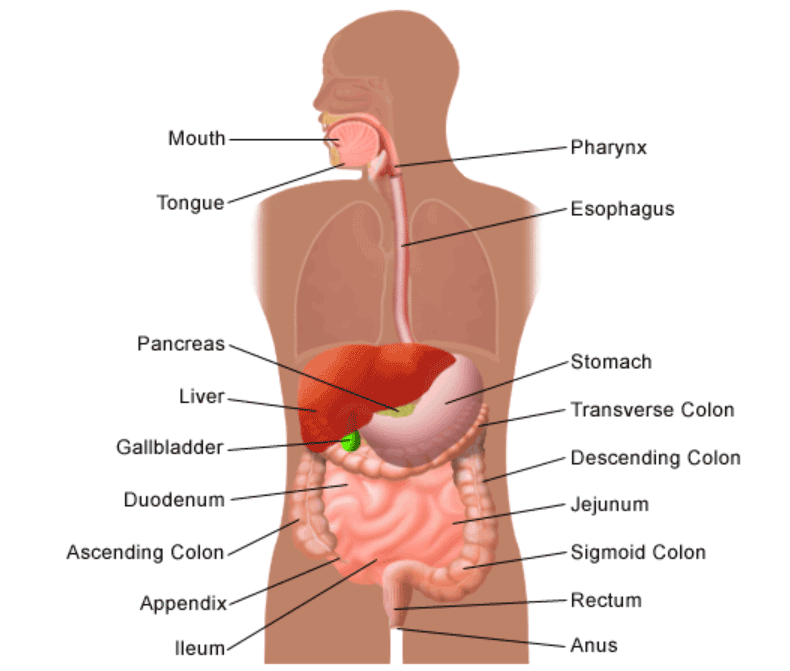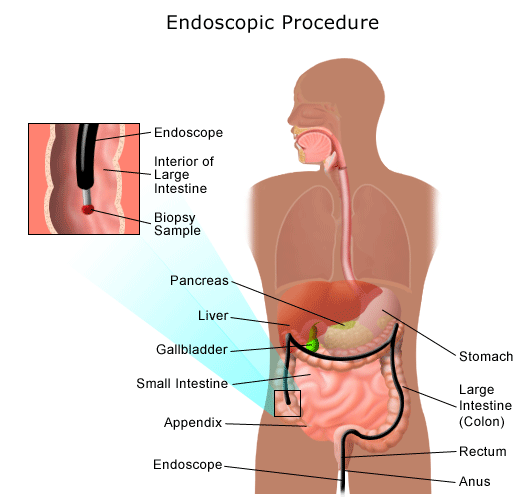what digestive organ absorbs water from food what two systems work to deliver gases in the body
Gas in the Digestive Tract
What is gas in the digestive tract?
Gas in the digestive tract is created from:
-
Swallowing air
-
The breakdown of certain foods by the bacteria nowadays in the colon

Everyone has gas. It may be uncomfortable and embarrassing, but it is not life-threatening. Gas is eliminated by burping or passing it through the rectum. Nigh people produce about 1 to 4 pints of gas a day and pass gas about 14 times a twenty-four hour period.
Well-nigh gas is made upwardly of odorless vapors--carbon dioxide, oxygen, nitrogen, hydrogen, and sometimes methane. Bacteria in the large intestine release gases that contain sulfur and produce an unpleasant aroma of flatulence.

Motion Mysteries: Solved!
Digestive problems tin be maddeningly hard to pivot down. Often, symptoms that manifest every bit gut troubles are actually signs of illness somewhere else. Explore four complex cases that stumped some of the state'southward leading GI experts.
What causes gas in the digestive tract?
Gas in the digestive tract comes from two sources:
-
Aerophagia (air swallowing). This is commonly caused by eating or drinking rapidly, chewing gum, smoking, or wearing loose dentures.
Belching is the way well-nigh swallowed air leaves the stomach. The remaining gas is partially absorbed into the small intestine and a minor amount goes into the large intestine and is released through the rectum.
-
Breakdown of sure undigested foods by harmless bacteria naturally present in the large intestine (colon)
Some carbohydrates (sugar, starches, and fiber) are not digested or absorbed in the small intestine because of a shortage or absence of certain enzymes. The undigested or unabsorbed food then passes into the large intestine, where harmless and normal leaner intermission downward the food. This process produces hydrogen, carbon dioxide, and, in about 1-tertiary of all people, methane gases, which are released through the rectum.
| Foods that normally cause gas |
|---|
According to the National Institute of Diabetes and Digestive and Kidney Diseases, most foods that contain carbohydrates tin crusade gas, however, fats and proteins cause little gas. Foods that cause gas include the following:
|
What are the symptoms of gas?
Chronic symptoms acquired past too much gas or by a serious disease are rare. The following are the about common symptoms of gas. However, each private may experience symptoms differently. Symptoms may include:
-
Belching. Belching during or after meals is normal, but people who belch oftentimes may be swallowing too much air and releasing it before the air enters the breadbasket.
Chronic belching may also indicate an upper GI disorder, such as peptic ulcer disease, gastroesophageal reflux affliction (GERD), or gastritis.
Co-ordinate to the NIDDK, rare, chronic gas syndromes associated with belching include the following:
-
Meganblase syndrome. Meganblase syndrome causes chronic belching. It is characterized by astringent air swallowing and an enlarged chimera of gas in the stomach following heavy meals. Fullness and shortness of breath acquired by this disorder may mimic a heart attack.
-
Gas-bloat syndrome. Gas-bloat syndrome may occur after surgery to correct GERD. The surgery creates a one-way valve betwixt the esophagus and stomach that allows food and gas to enter the tum.
-
-
Flatulence. Passing gas through the rectum is chosen flatulence. Passing gas fourteen to 23 times a day is considered normal.
-
Abdominal bloating. Bloating is usually the result of an intestinal motility disorder, such as irritable bowel syndrome (IBS). Motion disorders are characterized by abnormal movements and contractions of intestinal muscles. These disorders may requite a false sensation of bloating because of an increased sensitivity to gas.
-
Splenic-flexure syndrome is a chronic disorder that may be caused by gas trapped at bends (flexures) in the colon.
-
Crohn's disease, colon cancer, or any disease that causes intestinal obstruction, may also cause intestinal bloating.
-
Internal hernias or adhesions (scar tissue) from surgery may crusade bloating or pain.
-
Fatty foods can delay stomach elimination and cause bloating and discomfort, simply not necessarily likewise much gas.
-
-
Abdominal hurting and discomfort. Gas in the intestine causes hurting for some people. When it collects on the left side of the colon, the pain tin can exist confused with center disease. When information technology collects on the right side of the colon, the hurting may experience like the pain associated with gallstones or appendicitis.
The symptoms of gas may resemble other medical atmospheric condition or problems. Always consult your doctor for a diagnosis.
[[digestivehealth]]
How is gas in the digestive tract diagnosed?
Symptoms of gas may be caused by a serious disorder, which should be adamant. In add-on to a complete medical history and concrete examination, your doc may advise the following activities to assist in the diagnosis:
-
Abdominal X-ray
-
Food diary. You may be asked to keep a diary of foods and beverages consumed for a specific time menstruum, and/or to count the number of times you pass gas during the day.
-
Colonoscopy. For people 50 years of age and older, and for those with a family unit history, the possibility of colorectal cancer is considered. Colonoscopy is a procedure that allows the md to view the unabridged length of the large intestine, and can often help place abnormal growths, inflamed tissue, ulcers, and bleeding. It involves inserting a colonoscope, a long, flexible, lighted tube, in through the rectum up into the colon. The colonoscope allows the medico to see the lining of the colon, remove tissue for further examination, and maybe treat some problems that are discovered.

-
Sigmoidoscopy. A sigmoidoscopy is a diagnostic procedure that allows the md to examine the inside of a portion of the big intestine, and is helpful in identifying the causes of diarrhea, abdominal hurting, constipation, abnormal growths, and bleeding. A curt, flexible, lighted tube, chosen a sigmoidoscope, is inserted into the intestine through the rectum. The telescopic blows air into the intestine to inflate it and brand viewing the inside easier.
-
Upper GI (gastrointestinal) series (too called barium consume). For chronic belching, your md will wait for signs or causes of excessive air swallowing and may request an upper GI serial. An upper GI serial is a diagnostic test that examines the organs of the upper part of the digestive organization: the esophagus, tummy, and duodenum (the first section of the small intestine). A fluid called barium (a metal, chemical, chalky, liquid used to coat the inside of organs then that they will show upwardly on an X-ray) is swallowed. X-rays are and so taken to evaluate the digestive organs.
[[gastropages]]
Handling for gas in the digestive tract
Specific treatment for gas in the digestive tract will be determined by your doctor based on:
-
Your historic period, overall wellness, and medical history
-
Extent of the condition
-
Your tolerance for specific medications, procedures, or therapies
-
Expectations for the course of the condition
-
Your opinion or preference
Preventing gas in the digestive tract
The most mutual means to reduce the discomfort of gas include the following:
-
Changes in the nutrition
-
Medications
-
Reducing the amount of air swallowed
spencerthallusithe.blogspot.com
Source: https://www.hopkinsmedicine.org/health/conditions-and-diseases/gas-in-the-digestive-tract
0 Response to "what digestive organ absorbs water from food what two systems work to deliver gases in the body"
Post a Comment